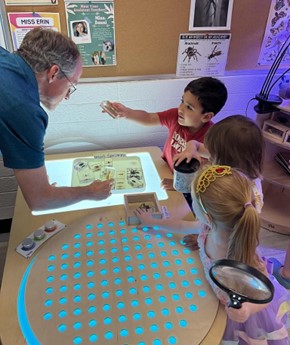
Bugs in our outdoor area prompted children to create questions and explore their roles, allowing for an in-depth investigation of this topic.
Phase 1: Observing bugs
Discovery Accordion Closed
Children have found a variety of bugs outside of the classroom. There were a mix of reactions to the bugs, ranging from excited to scared.

Above are displays of student quotes, citing what they already know about bugs.
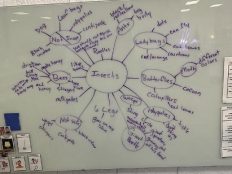
Children completed a topic web with the teachers to identify concepts related to bugs.
We brought in more bugs to the classroom for further exploration.
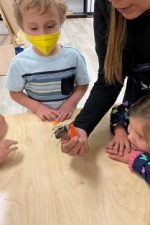
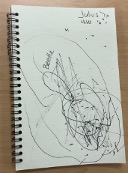
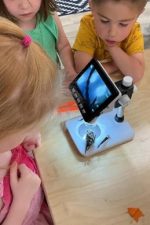
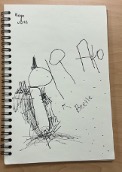
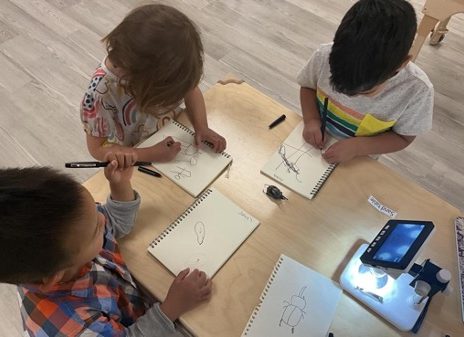
Children looked under the microscope as they studied the bodies of Rhinoceros beetles. We noticed that they have hairs on their legs, they have a big horn, and are stinky. Why was it stinky? Children were curious to know why our rhinoceros beetles were deceased. They began to come up with reasons as to how and why our beetle friend was dead.
Brena: Why do you think he died?
Everett: I think he got extinct.
Austin: like the dinosaurs got extinct.
Kaia: I see hair.
Brena: What color?
Kaia: Yellow!
Aiden: There some poop on it. *No worries…there was no poop 🙂
Kailani: What happened to them?
Brena: Maybe they change color when they die?
Aiden: Why is his head broken? Maybe he hit his head on a tree and bonked.
Kialani: Maybe the green stuff hurt his body. HE’S BROKEN! *Beetle corpse broke apart*
Aiden: *Smells the beetles head* Eww it stinks
Brena: Do you think the bug was wet or dry?
Everett: Dry.
Our close observation of the beetle gave students a chance to study an insect that was not alive. There were opportunities to count body parts and make note of it’s hard shell, it’s legs and the orange hair. The beetle was fully intact at the beginning of the observation and with a lot of handling, the head fell off of the body. This discovery led to students looking inside the body and insect and pointing out the smells that came from it.
Spider Observations Accordion Closed
The class caught a wolf and jumping spider in our classroom at the end of last week. Our students have been captivated by it’s movements, size and appearance. Ms. Carmen built each spider it’s own habitat so that students can observe and talk about the different bugs and insects in our classroom. During this small group activity, students were asked to observe the spider in it’s habitat and to create their own drawing.
Austin did not want to draw a spider but did observe it. He was asked what he knew about spiders and answered, “Eight legs. He’s mad. Because he’s trying to break through the walls. AHH, the leg was trying to get out. They have two bodies. Ms. Carmen told us a Wolf Spider.”
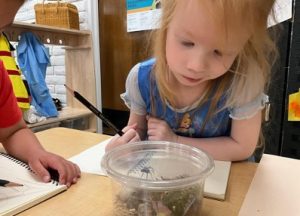
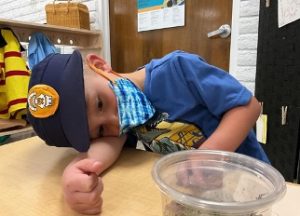
Kaia observed our class Wolf Spider and attempted to draw it in her journal. She used a four finger grasp on her pencil when attempting to draw the spider. She also attempted to copy the word “Spider” after it was modeled for her.
Observing isopods Accordion Closed
Everett and Elliot are observing the new bugs that came into the classroom this morning. They appeared excited as the lid opened on the container and were given permission to handle the insects.
Ms. Brena sat with them and talked about the isopods.
Everett: Is there something in there, can I see what’s in there? (Pointing to the jam jar)
B: What are you guys looking at?
Everett: It looks so cute.
B: Why is it cute?
Everett: He likes to be like a roly Polly, kind of.
Everett laughing as the isopod climbs up his hand and arm. Everett: He’s climbing up my arm. Elliot: It tickles, it tickles!!
Kaia: It’s so cute.
Elliot: It tickles so much.
B: They really stick to you, don’t they.
Everett: Yeah, they stick!
Elliot: And tickle! B: What’s the black part going down the middle of his body?
Everett: That’s just how he was made, that’s inside his body.
B: It’s inside his body? Everett: Yep, it’s the bone that holds everything in case it falls.
They continue to make more observations.
B:Where do you think they live?
Everett: In here (pointing to the habitat)
B:Where do you think Ms. Carmen found them?
Everett: Our house, I think.
B: She went to your house?
Everett: No, at Ms. Carmen’s house.
Andres: I want a rolly Polly.
Everett and Elliot: These aren’t rolly pollies,
B: If they’re not rolly pollies, what are they??
Everett: They’re….I don’t know. I’m going to ask Ms. Carmen what kind of bugs these are.
Elliot goes to ask her. Elliot comes back. Elliot: They’re isopods. Everett: They’re isoquads!
Family contributions Accordion Closed
Families are asked to contribute artifacts or pictures of experiences they may have had with our project topic. Ami brought in an insect book from home to share with the group. She talked about her sticker book. Children shouted out the bugs they saw on the pages, such as a dragonfly, butterfly, or blue bugs and pink bugs. Ami called on a few children raising their hands to share their thoughts. She practiced holding up the book to show the pictures to the class.
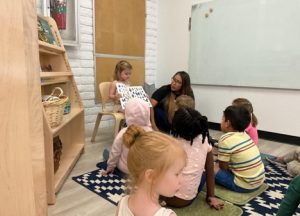

Austin brought worms for the class to investigate. Austin found worms in his backyard due to a water leak.
Ms. Carmen: His little tail got cut off. Did you see that? Do you think that he feels that?
Austin: It’s so long. Look how long it is. They’re trying to go into the dirt.
Olivia: Hey, I want the big boy. Oh no! My baby worm.
Austin: I really want to put some of that dirt in here.
Ms. Carmen: We can try, but we will have to separate that dirt too.
Amanita: Olivia, I found this rock!
Ms. Carmen: You’ve been doing so good touching them. It’s okay to be a little scared.
Ms. Jolene: Everett, what do you notice about the worms?
Everett: They’re slimy.
Amanita: He has poopy! He poop on your arm.
Ms. Jolene: Ella, what do you notice about the worms
Ella: Baby worms. They slimy.
Aiden: Teacher, look. It not moving. (He put it in a small bug container.)
Ms. Carmen: We have to put it back in the soil. If it is exposed to air, it will dry up.
Research questions Accordion Closed
After having some time to explore bugs, children were asked to think about what questions they have about bugs:
Everett: Why do insects eat other bugs?
Austin: Why does lady bugs eat plants?
Elliot: Why do insects eat rolly pollies?
Aiden: A bad guy, why is the bad guy take somebody’s purse? Why do bad guys hurt the bugs? (Was said first?)
Ella: What about a unicorn eats bugs?
Zanthur: Why spiders eat bugs?
Lily: Why does the bee dinosaur eat bugs?
Carmen: Why aren’t bugs as big as we are?
Brena: What happens to the bugs in the winter?
Micaela: Where do bugs live?
Aiden: Do spiders eat bugs?
Elliot: What if a spider eats a tarantula?
Ella: What if bugs eat plants?
Leora: Do spiders go to the water?
Andres: Do spiders eat rolly pollies?
Phase 2: Investigating bugs
Bug compositions Accordion Closed
Children collected natural materials to create bugs. We laid out materials; rocks, sticks, leaves, pinecones for students to create their own bugs. Everett took a selection of rocks and created his own earthworm home.
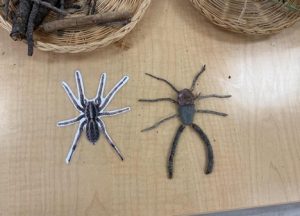
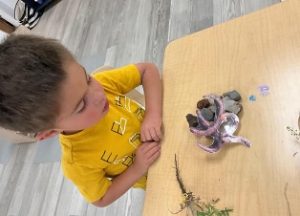
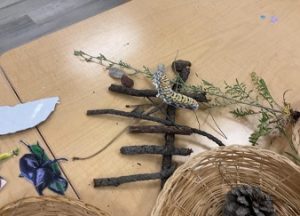
Everett: I’m done, Ms. Brena. I had a home for the earthworms.
Aiden created a home for the caterpillar using a plant, twigs.
Aiden: Look, teacher. I made a house.
Brena: That’s a nice house, which insect do you think will love to live there?
Aiden: Uhmm….. **Aiden sorting through the photos of bugs. Aiden: Maybe this one. **PIcks up dragonfly.
Aiden: But he just fly away.
Brena: What wont fly away, but would like to crawl around on the branches? Aiden: The caterpillar!


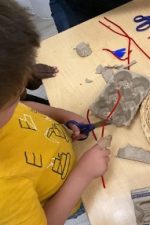
Children ventured outside of paints and brushes by incorporating new materials into art: shapes, pom-pom’s, sequence, stickers, egg cartons, etc. Each child took the time to form insects with the materials provided; we had spiders, dragonflies, and butterflies. Mrs. Brena open discussion on the body structure of certain insects. We recalled that insects have three parts to their body: head, thorax, abdomen. With some children building butterflies, we discussed why certain insects have wings and the details they have.
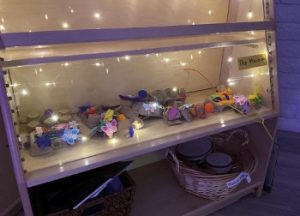
Children continued to make iterations of bugs through different art mediums.
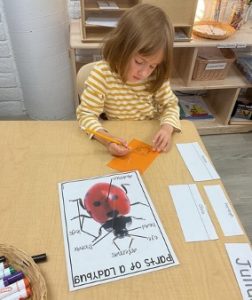
Rayo drew a ladybug by looking a picture of a ladybug with labeled body parts. She approximated her first name. She approximated copying the word Ladybug with a model. Rayo uses a tripod grasp when writing.
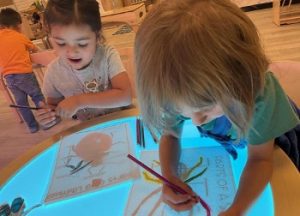
Rayo and Olivia spent about 45 minutes tracing a ladybug and a spider. They used printed images that were in the writing center, the light table, coloring pencils and a white sheet of recycled paper. They adjusted their light table light and expressed that it was easier to see through certain colors. They were talking to each other about creating a rainbow spider and a rainbow ladybug. After finishing 1/2 of the ladybug, Olivia noticed she was also coloring in the name tag indicators.
Olivia: Oh no, this is not part of the ladybug!
Rayo: It’s okay, it’s still a rainbow bug.
They continued working until they completed the entire bug and finished right before we cleaned up to head outside.
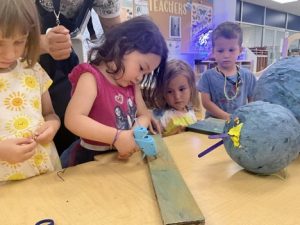
Children experimented with paper mâché to create life-size spiders and spider webs.
Ms. Jolene: “What could we do with the wire? How many legs does a spider have?”
Ella: “8!”
Ms. Jolene: “Where should we put the legs? Let’s vote”
Kaia: “Bottom!”
Ms. Jolene: “Do you think we could use the wire for anything?”
Ella: “No.” Ms. Jolene: “Maybe a bee, an ant, butterfly wings.”
Kaia: “I need to cut it.” Uh oh! Spider fail, student rescue!
Children took turns carefully using the hot glue gun with adult supervision. They hot glued the cardboard, however, the cardboard was not sticking correctly to the spiders body. Ms. Jolene: “Our legs aren’t sticking what can we do for legs?” Rayo: “Pipe cleaners!” We will continue to let the children problem solve what we could use for spider legs.
Specimen observations Accordion Closed
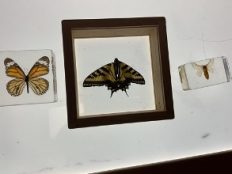
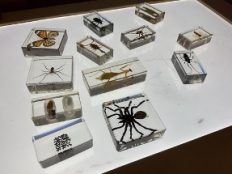
During morning meeting, Ms. Jolene introduced insect specimens to the group. We talked about handling the specimens with care and the names of each one.
Olivia: Wow, look at that butterfly. Kailani: It’s so beautiful!
Olivia: Butterflies don’t bite.
Ella: Look! Olivia: Yeah, they’re real!
Everett: Holy smokes! Where did the entomologist find these??
Brena: Out in the wild, I’m sure. Most likely already dead before they picked it up.
Kaia: Can it see the butterfly? *Picks it up* Whoa! Look at it! It’s not an insect, it will never be an insect. Brena: Which one isn’t it an insect? Kaia: The butterfly.
Brena: Why not, Kaia? Kaia: Because it has wings, insects don’t have wings.
Language and literacy experiences Accordion Closed
Teachers used fiction and non-fiction literature to deepen their knowledge on the bug project.

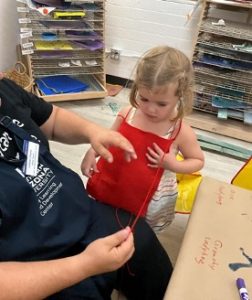
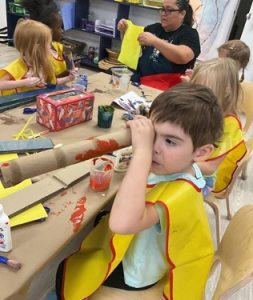
Children used the book The Grouchy Ladybug to reenact the story. Students had to problem solve and use their creativity to determine how to make a character costumes for their Grouch Ladybug movie. They cut, painted, drew, threaded yarn, and drew to make their costumes.
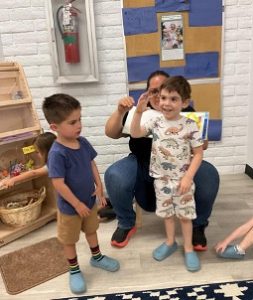
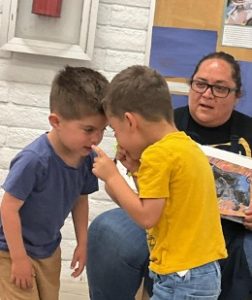
Students auditioned and chose character parts for “The Grouchy Ladybug” movie. Once all characters were assigned, we rehearsed reading the book with students rehearsing their parts.
We introduced two new vocabulary words: predator and prey. Children learned about the difference and were able to further understand based on the examples we discussed as a group. J: A predator is an insect that eats other insects. Can you think of other animals that eat other insects? Everett: Black widow Aiden: Giraffes . J: Giraffes are not predictors, but do you think another animal can eat a giraffe? J: Do you think ladybugs are predictors? Everett: no. J: They are because they eat aphids. Ami: Spiders. *Kaia brings her grasshopper into the science center* E: What do you think about Kaia’s grasshopper? Is it a predator or not a predator?
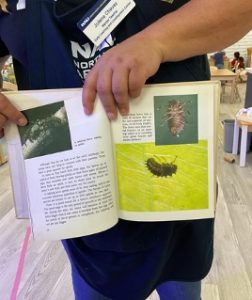
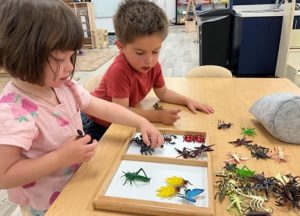
Ella, Everett, and Rayo sorted insects by whether or not they are predators. We researched what the different insects ate.
Ms. Jolene: Is a butterfly a predator?
Ella: Yeah it is!
Ms. Jolene: Let’s look it up. No, butterflies are not predators they eat flower nectar.
Rayo: This is a fly? What do flies eat?
Ms. Jolene: Let’s look it up. They eat leaves and vegetables. They are not predators. Everett, do you think a wasp is a predator?
Rayo: I think they eat flies.
Ms. Jolene: What about a praying mantis?
Everett: What do dinosaurs eat?
Ms. Jolene: It depends. Herbivores have flat teeth and eat plants. Omnivores have flat teeth and sharp teeth so they eat plants and other animals. Dinosaurs with sharp teeth are carnivores and eat other animals.
Rayo: T-Rexes keep other predators away.
Everett: They eat meat with their pointy teeth.
Rayo: These are predators! (Holding up two spiders)
Ms. Jolene: What do those spiders eat?
Rayo: They eat other not predators. I think they only eat grasshoppers.

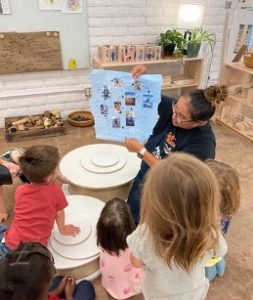
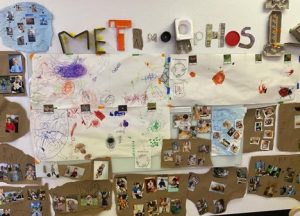
We have discussed the metamorphosis of the butterfly, ant, ladybug and spider. As we continue to study these life cycles, we also studied the life cycles of our own students to see the changes and growth in everyone.
Carmen: What happened to Lani?
Kaia: He grew! Carmen: How did she grow?
Lani: I grew my teeth
Carmen: Who’s this? (Showing a picture of Lani in her mom’s stomach)
Lani: Mommy!
Carmen: Did you know Lani is in this picture? Do you guy see Lani?
All: Nooo! Carmen: She’s in her tummy!
Carmen: Do you guys see how much bigger you’ve gotten?
Carmen: First she was a baby, then she was a toddler, and now she’s a preschooler! We moved on to talk about Lily’s life cycle.
Carmen: Does this look like Lily right now?
Ami: No Lily: I was just a little baby and now i turned to old and now I have bigger eyes and i was in mommas tummy.
Carmen: Do you guys notice anything about her legs? Carmen: Can baby Lily walk?
All: Nooo!
Carmen: We have lily at 6 months, then her at 1 years old and then she’s walking on her feet, and now she’s two years old in this picture
We moved on to Ami’s life cycle.
Ami: My daddy was brushing my hair with a brush in my bathtub in this picture
Carmen: You were only one month old in this photo! Carmen: This is her at five months, do you guys see how she already looks different?
Carmen: In this picture here you were 11 months old. And now in the next photo what can you tell me.
Ami: This is a fun dress and i was staying at home with my doggie.
Carmen: What is different about Ami?
Ami: In that one i was younger.
Kaia: This one is baby Ami.
We are talking about Kaia and Scout’s life cycle.
Carmen: How can you tell the difference between Kaia and Scout?
Scout: Because its Scout. Kaia: This is me!
Carmen: Where are you guys in this photo? Kaia: We are with Dede.
Carmen: Who is this happy family right here?
Kaia: This is me, this is my dad, this is my mom, and this is my sister
Field expert: Abuelita, the entomologist Accordion Closed

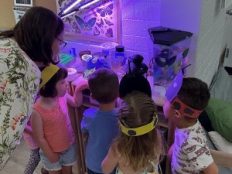
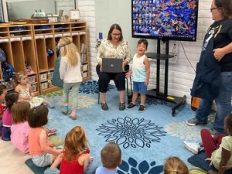
Staff requested that Andres’ Abuela come in to tell us about being an entomologist. She taught students about the difference between insects and spiders, the life cycles of butterflies and ladybugs, and answered student questions. Then students made ladybug crowns with both of Andres’ grandparents.
Andres: This is my granny, she’s going to be the teacher today.
Sandra: My name is Sandra, I am Andres’ grandma. Do you know what an entomologist is? Is any of you an insect?
Everett: humans
Aiden: kids too!
Sandra: Who has gone out and found insects in the wild?
Elliot: I found a ladybug.
Andres: I found a big spider with Julius.
Sandra: Entomology is the study of…
Elliot: bugs!
Sandra: Who can tell me why an insect is called an insect and why a spider is called a spider? How do we know an insect is an insect?
Elliot: Beetles eat some crickets.
Sandra: Spiders only have two parts of the body: the head and thorax is one part and the abdomen. How many legs to humans have?
Andres: two!
Sandra: Insects always have 6 legs. There are thousands of butterflies.
Andres: You have butterflies on your shirt!
Kailani: Did you know I have centipede in my house.
Sandra: Some centipedes are bad and some are poisonous. You have to learn about the difference. Butterflies come in many different sizes, some are big and some are small. All the them go through the same process called the life cycle.
*Ms. Jolene reviewed our vocab word: met-a-mor-pha-sis*
Sandra: How many have had lady bugs crawl over you?
Kailani: Did you know when ladybugs crawl you they tickle you.
Sandra: They build a pupa that will help them turn into pretty ladybugs. Ladybugs can live up to a year. There are ladybugs of many different colors: red, blue, pink, yellow, etc. *points to pink ladybug* this is my favorite ladybug – I did my research on this one.
Field expert: NAU Bug Lab Accordion Closed
Dr. Hoffstetter and two students from NAU’s Insect Ecology and Management Lab completed a field visit to the ELDC. Children had the opportunity to ask questions about bugs, as well as explore the specimens brought from the lab.
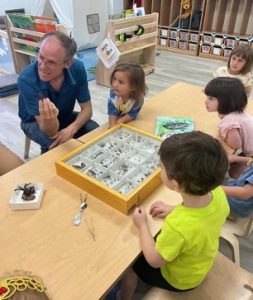

Rich: Who are we/what do we do?
Kaia: Study bugs! Rich: Study insects.
Zanthur: Why some ants eats bugs?
Rich: A lot of insects when they are young- they don’t look anything like the adult. See, this one is alive (about a larva) and it’s going to turn into a beetle. Zanthur: ahhh ahhh it’s real! (reacting to larva/worm on his hand).
John: Yes, this little worm will turn into a black beetle.
Lily: A black beetle?
John: Yes, do you want to hold it? (Lily holds worm in hands, observing it)
John: He wants to know how the larva turns into a beetle. Rich: well it’s called metamorphosis, which is a big word.
Rich: Why do you think?
Aidan: Caterpillars eat apples.
Rich: When you guys grow you just get bigger, right? But how do insects get bigger?
Ms. Jolene: Do you remember what that’s called?
Rayo: Molting!
Ms. Jolene: Is that heavy or light? (About cockroach molt.) Scout: Big
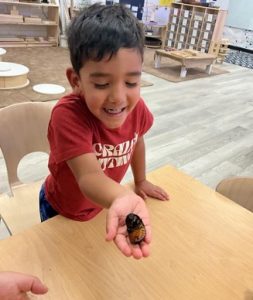
Rich: This is a molt of a tarantula, there is no spider in there, it is perfectly safe to hold. Student: What is this?
Rich: It’s a bird-eating tarantula.
John: It’s not alive anymore. (talking about molt)
Lily: It’s not moving. John: Yes, because it’s not alive anymore.
Emma: Do you want to see super worms? Andres: I want to see it!
Ms. Jolene: What does that turn into? Emma: Bigger black beetles.
Aidan: Where’s the mommy? Rich: The mommy is back in our lab.
Ms. Erin: What does that feel like on your hand? Aidan: It tickles.
Erin: What does that turn into? Rayo: A big beetle.
Rich: We are going to pull out a bigger insect. Do you know what this is called?
Kailani: Is it tickling you? Rich: It is called a Madagascar hissing cockroach.
Rich: How does an insect breathe?
Rayo: With holes! Rich: That’s right! That’s how it makes that sound. This one likes my warm hand. Kailani: I want to touch it.
Rich: This is a male. You know why this is a male? It has horns.
Kailani: Remember last time we saw a stag beetle, it has a really long antenna.
Rich: Are you afraid because it’s big? Lani: Yes.
Ms. Erin: Is there a bug in there? (Talking about cockroach molt)
Rayo: No. Ms. Erin: Aidan do you remember how it makes the noise?
Aidan: nods Erin: How? Aidan: hssssssssssssss
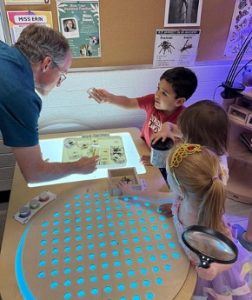
Our young entomologists wanted to share our ELDC Bug Lab with our new NAU entomologist friends! Children took Rich over to the light table and pulled out our classroom specimens.
Ella: what is this? Rich: Those are moths?
Rayo: Hey, I found one of those in my driveway.
Ms. Jolene: What’s the coolest bug you’ve ever seen?
Rich: I have seen a walking stick this long (stretching his arms out wider than his body) the biggest insect in the world.
Rich: What do you need in your bug lab? (Referencing student project)
Andres: When there are bugs, we need to spray it.
Ms. Jolene: We don’t spray our insects, we take care of them.
Ms. Erin: Zanthur, do you see the legs on that? (talking about beetle larva)
Zanthur: Yea, I see it moving.
Zanthur: Ms. Erin, it’s happy!
Rayo: One day I saw a black widow on its web, eating a medium grasshopper. Also after it had web on it. Miss Erin: What had web on it?
Rayo: But it could still hop- I tried to get it off with a fork and a knife.
John: That is a dung beetle. Lani: These ones can eat dog poop. Rayo: I saw flies eating poop
Phase 3: Culminating event
Recreating the Bug Lab Accordion Closed
Children decided they wanted to recreate a Bug Lab after the field visit from Dr. Hoffstetter.

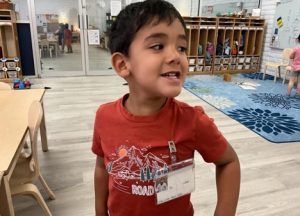

Children made badges in preparation of being an entomologist. They cut out their pictures, wrote their names, and learned to tie knots with a strong. Andres cut out his photo, glued it on and wrote an A for Andres.
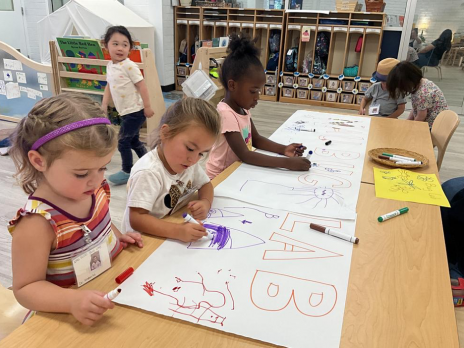
Students worked together to design our Bug Lab Posters.
Aiden: I drew a bug. Can I go now? Andres: Look, Ms. Jolene, it underwater.
Ms. Jolene: It’s a water bug?
Andres: Si, a water bug. Everett: Look how many stickers I took off. 1500! Ms. Jolene: Scout, what are you drawing? Scout: A spider web.
Ms. Jolene: You made a spider web? Scout: Yeah. I the spider.
Ms. Jolene: You are the spider? Scout: Yeah.
Leora: I draw a dragonfly!
Sharing with families Accordion Closed
The entomologists used the Bug Lab as a way to recreate and share the experiences they had with families. Children wore their badges, a “lab coat” and safety glasses.
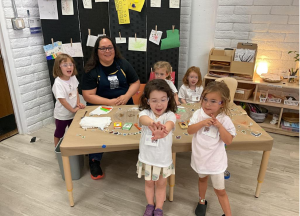
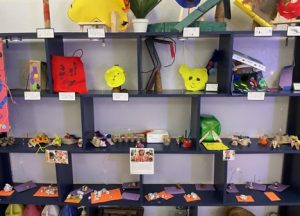
Entomologist Kaia gave her family a tour of our Bug Lab Art Museum. Entomologist Aiden was going to help, but he found himself super busy eating bugs!
Our student entomologists worked extremely hard during our Project to create Bug art out of recyclable materials, clay, wire, art supplies, and aluminum foil. Our Bug Lab Art Museum also displayed the wonderful costumes that our entomologists created for our movie!
Entomologists Ella and Everett taught our Bug Lab guests all about our live insects and spiders. During our project, our student entomologists had to create habitats, care for and feed our insects with the assistance of our Bug Expert, Ms. Carmen. Their favorite part was catching our insect friends of course!
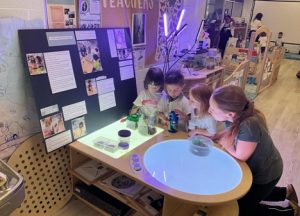
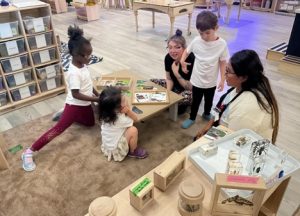
Entomologists Zanthur, Leora and Lily described our bug specimens to our bug lab guests. Our specimens gave our entomologists a chance to observe, question, and learn about the characteristics of our insect and spider friends.
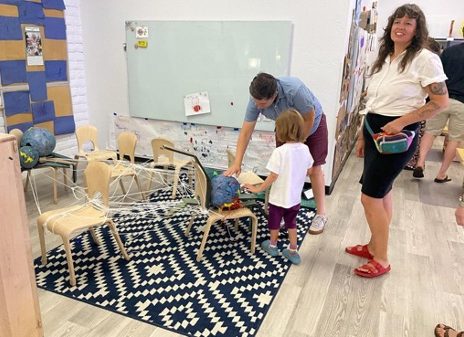
Our entomologists worked hard to make two giant paper-mache spiders and their web. We failed many times but our entomologists were persistent problem solvers.
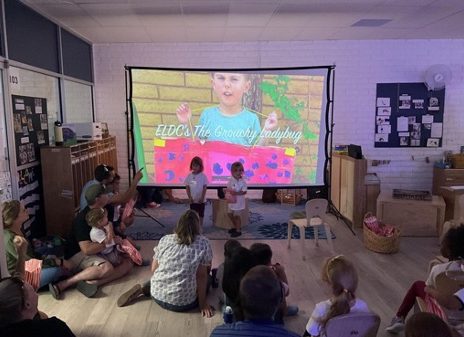
One of our entomologists’ favorite books was “The Grouchy Ladybug” by Eric Carle. They were all so animated during the read aloud that we decided to make our own movie. They auditioned for the part of the Grouchy Ladybug and once Everett was selected, everyone else chose which character they wanted to play. They worked hard to plan and create their costumes. They rehearsed their lines and practiced with their costumes. Filming was a success and Ms. Brena Spielberg edited our film into the masterpiece we premiered at our Bug Lab Event.
